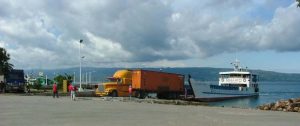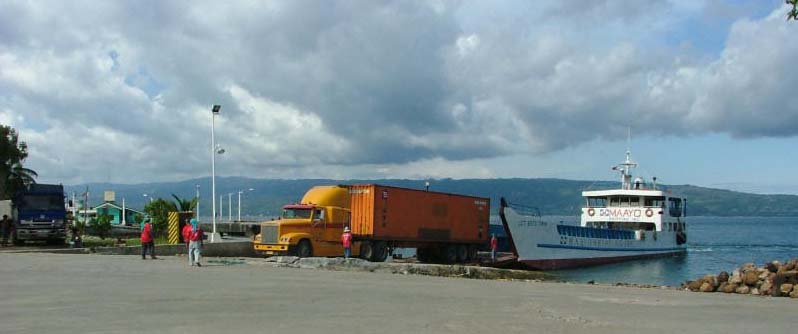 Despite easing of congestion at Manila ports, truckers still see 2015 as another challenging year due to existing and pending government policies.
Despite easing of congestion at Manila ports, truckers still see 2015 as another challenging year due to existing and pending government policies.
Three trucking groups—Confederation of Truckers Association of the Philippines (CTAP), Integrated North Harbor Truckers Association (INHTA), and Aduana Business Club, Inc. (ABC)—all told PortCalls that 2015, like 2014, will still be a struggle for the sector mainly due to the threat of the proposed phase-out of trucks 15 years and older, and the impact of the non-confirmation year (NCY) policy of the Land Transportation Franchising and Regulatory Board (LTFRB).
INHTA president Teodorico Gervacio said LTFRB’s NCY policy, which was implemented June last year, will take out 7,322 trucks from the roads by end of this year – and those are just units that would have normally been processed through LTFRB’s Central office. By 2019, over 19,030 trucks will be out of service for exceeding the age limit.
While there is no policy yet on the phase out of 15-year-old trucks, the NCY policy already limits the number of years a truck can be registered or confirmed, depending on its age.
LTFRB, realizing the impact of the NCY policy, issued on May 20 Board Resolution (BR) No. 6-2015 that allows affected truckers to file a motion to allow confirmation of their truck units and prove their trucks are still roadworthy despite being old.
“If this (NCY policy) will not be suspended, expect a worst-case scenario of port congestion and skyrocketing trucking rates,” Gervacio said.
CTAP director Ruperto Bayocot, who considers the NCY rule the biggest problem for the industry today, said allowing or disallowing trucks aged 15 years and above to be confirmed or registered under BR No. 6-2015 will still be under the discretion of the LTFRB.
Phasing out of older trucks has been an issue even before 2014. Truckers said roadworthiness, not age, should be the basis for giving out a franchise. On May 18, truckers staged a protest in front of the LTFRB headquarters against the 15-year phaseout proposal. It is estimated that more than P50 billion will be needed to replace the almost 20,000 trucks that will be affected if the proposed phaseout is implemented.
The government has yet to decide whether to implement the phaseout or come up with another measure instead. LTFRB chairman Atty. Winston Ginez said they are still studying the policy but that the final verdict will come from Transportation Secretary Joseph Emilio Abaya.
In the meantime, BR 6-2015 is being implemented as some kind of a compromise.
Nelson Mendoza, president of Awards Cargo Agency Phils., Inc. and of United Port Users Confederation, said that aside from the phase-out, additional restrictions being implemented by local authorities compound the problems of truckers.
Since last year, Mendoza said several cities and another agency have been implementing new traffic regulations, such as truck bans and truck route schemes.
“We are optimistic that unforeseen hurdles for the remainder of the year would not be forced upon the truckers. Otherwise, given the volatility of the situation, we might see a repeat of 2014,” Mendoza said.
Acid test
Truckers described 2014 as an “acid test” for the industry with several policies deemed inimical to the industry being introduced, such as the Manila City daytime truck ban that triggered massive congestion at Manila ports; truck bans by other local government units (LGUs); and Joint Administrative Order No. 2014-01 which increased penalties for colorum (unfranchised) public utility vehicles.
As a result, truck turnaround slowed, there were greater problems involving towing, and some truckers were unable to operate due to the NCY policy.
ABCI’s Mary Zapata and Samson Gabisan said lower demand for truck services will also contribute to making 2015 particularly challenging.
Although the first two months of 2015 were “good for the trucking industry” with plenty of trips, Gabisan noted the months of March and April were lean.
“I think the truckers were able to profit during the Manila truck ban and port congestion. Now that there is no truck ban and port congestion, the industry is at the mercy of importers/exporters,” Gabisan said.
He claimed prevailing truck rates are now even lower than those published as guide rates by CTAP, exacerbated by cutthroat competition.
INHTA’s Gervacio added that towing and alleged “abusive” road-side smoke emission testing are part of this year’s concerns.
Moreover, he said “traffic congestion might worsen by end of third quarter because of road repairs and construction everywhere because of the upcoming national and local elections.”
On the bright side
But Gervacio noted opportunities for this year too. Among these is “an earlier peak season due to the upcoming national and local elections, because money will change hands from the politicians and the buying power of the people will increase.”
Despite apprehension over cargo movement due to different challenges faced by the trucking industry, Gervacio said they expect “a substantial increase in volume of cargoes, more than last year.”
Moreover, some projects seen to benefit truckers as well as other port stakeholders will be launched this year.
For one, Manila port operators will implement a container booking system expected to promote smooth truck movements and help truckers run more trips.
The Association of International Shipping Lines is already adopting an empty container return app which automates return of empty containers to off-dock container yards.
Beyond those projects, truckers said it would help if government synchronizes its policies and coordinates with all stakeholders before implementing any new decisions. – Roumina Pablo





